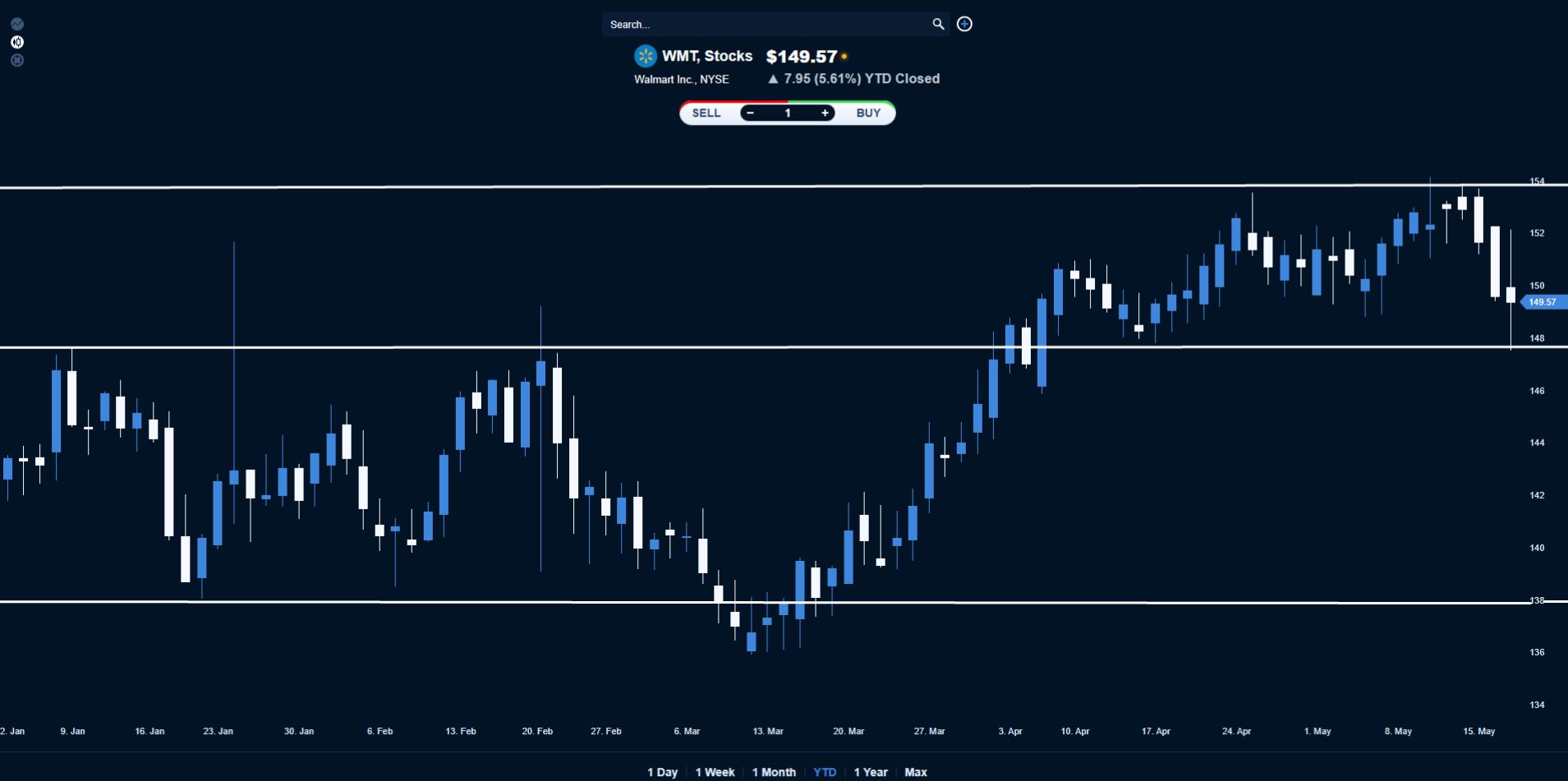Introduction
Walmart is a multinational retail corporation that has become a household name across the globe. With its vast network of stores and e-commerce platforms, Walmart offers a wide range of products and services to millions of customers every day.
Stock trading, on the other hand, is the buying and selling of shares or ownership stakes in publicly traded companies. It is a popular investment strategy where individuals or institutional investors aim to generate profits through the fluctuations in stock prices.
Investing in Walmart stock can be an attractive option for investors looking for long-term growth and stability. As one of the largest retailers worldwide, Walmart has consistently demonstrated its ability to adapt to changing market dynamics and deliver strong financial performance.
This article aims to provide an overview of Walmart stock trading, including why investors should consider investing in Walmart, how stock trading works for Walmart, and the factors that influence Walmart stock prices. We will also discuss the advantages and disadvantages of trading Walmart stock and provide some useful tips for investing in this popular company.
Whether you are a seasoned investor or just starting to explore the world of stock trading, understanding the dynamics of Walmart stock can help you make informed investment decisions and potentially reap substantial rewards.
Overview of Walmart
Walmart, founded in 1962 by Sam Walton, has grown to become the largest retail company in the world. With headquarters in Bentonville, Arkansas, Walmart operates a vast network of stores in various formats, including Walmart Supercenters, Walmart Neighborhood Markets, and Sam’s Club locations.
Known for its commitment to low prices and convenience, Walmart offers a comprehensive range of products, including groceries, household goods, electronics, apparel, and more. The company’s retail operations span across 27 countries, serving millions of customers each day.
In addition to its physical stores, Walmart has made significant strides in e-commerce, competing with online giants like Amazon. Through its website and mobile app, Walmart provides customers with the convenience of online shopping and offers various delivery options, including in-store pickup and home delivery.
Walmart’s success can be attributed to its strong focus on operational efficiency, supply chain management, and continuous innovation. By leveraging economies of scale and implementing advanced technology solutions, Walmart has been able to streamline its operations and offer customers quality products at competitive prices.
Beyond its retail operations, Walmart has diversified its business through ventures in financial services, digital media, and healthcare. This diversification strategy aims to capitalize on emerging trends and further strengthen the company’s position in the market.
Walmart is also committed to corporate social responsibility, focusing on initiatives related to sustainability, community development, and employee welfare. The company strives to minimize its environmental impact and supports charitable causes through partnerships and philanthropic efforts.
With an unparalleled reach and brand recognition, Walmart continues to be a dominant force in the retail industry. Its strong financial performance and ability to adapt to changing consumer preferences make it an appealing investment option for many.
What is Stock Trading?
Stock trading refers to the buying and selling of shares, or ownership stakes, in publicly traded companies. It is a popular form of investment where individuals and institutional investors aim to generate profits by capitalizing on the fluctuations in stock prices.
When you buy a stock, you are essentially purchasing a portion of ownership in the underlying company. This ownership entitles you to certain rights, such as voting in shareholder meetings and receiving dividends if the company distributes profits to shareholders.
Stock trading takes place in stock markets, which are platforms where buyers and sellers can trade securities. The most well-known stock markets include the New York Stock Exchange (NYSE) and Nasdaq in the United States, as well as international exchanges like the London Stock Exchange (LSE) and Tokyo Stock Exchange (TSE).
Stock prices are influenced by various factors, including the company’s financial performance, industry trends, market sentiment, and macroeconomic conditions. Investors analyze these factors to make informed decisions about when to buy or sell stocks.
There are two primary types of stock trading: short-term trading and long-term investing. Short-term traders, also known as day traders, aim to profit from short-term price fluctuations and typically hold stocks for a few minutes to a few weeks. In contrast, long-term investors aim to hold stocks for an extended period, often years, with the goal of benefiting from the company’s long-term growth and potential dividends.
Stock trading can be done through various channels, including traditional brokerage firms, online trading platforms, and mobile apps. These platforms provide investors with tools and resources to research stocks, place trades, and monitor their portfolios.
It is important to note that stock trading involves risks, as stock prices can be volatile and subject to market fluctuations. It requires careful analysis, risk management, and a long-term investment strategy.
Overall, stock trading provides individuals with the opportunity to participate in the financial markets and potentially grow their wealth through capital appreciation and dividend income.
Why Invest in Walmart Stock?
Investing in Walmart stock can offer several compelling reasons for investors looking to add a stable and potentially profitable asset to their portfolio. Here are some key factors that make Walmart stock an attractive investment:
1. Strong Financial Performance:
Walmart has a track record of delivering strong financial results. The company consistently generates significant revenue and profits, thanks to its scale, operational efficiency, and diverse product offerings. This financial stability can provide investors with confidence in the company’s ability to weather economic downturns and generate long-term returns.
2. Global Retail Dominance:
As the largest retail company in the world, Walmart has a massive global presence and a well-established brand. Its extensive network of stores and e-commerce platforms allows the company to reach millions of customers worldwide. This dominance in the retail sector positions Walmart for continued growth and resilience in the face of competition.
3. E-Commerce Growth:
Walmart has made significant investments in its e-commerce capabilities, positioning itself as a formidable competitor to online retail giants. The company’s online sales have experienced robust growth, and it continues to expand its digital offerings and omnichannel capabilities. With the increasing trend of online shopping, Walmart is well-positioned to capitalize on this shift in consumer behavior.
4. Diversification and Innovation:
Walmart continuously explores new avenues for growth and diversification. The company has ventured into various areas, including financial services, digital media, and healthcare. This diversification strategy allows Walmart to leverage its existing customer base and infrastructure while exploring new revenue streams and business opportunities.
5. Dividend Potential:
Walmart is known for its commitment to returning value to shareholders. The company has a consistent track record of paying dividends to its shareholders, making it an attractive choice for income-focused investors. Dividends can provide a steady stream of passive income and contribute to long-term wealth accumulation.
6. Commitment to Sustainability:
As environmental, social, and governance (ESG) concerns gain prominence, Walmart has made significant efforts to address sustainability issues. The company has set ambitious goals to reduce its carbon emissions, increase the use of renewable energy, and improve supply chain sustainability. These initiatives align with investor demand for ethical and responsible investment options.
While it’s important to note that investing in any stock involves risks, Walmart’s strong market position, financial performance, and commitment to innovation make it an appealing option for investors seeking long-term growth and stability.
How Does Walmart Stock Trading Work?
Walmart stock trading follows a similar process to trading any other publicly traded stock. Here’s how the Walmart stock trading process works:
1. Stock Exchange Listing:
Walmart stock is listed and traded on major stock exchanges, such as the New York Stock Exchange (NYSE) under the ticker symbol “WMT”. Investors can access Walmart’s stock through brokerage accounts or online trading platforms that provide access to these exchanges.
2. Placing Buy or Sell Orders:
Investors can place buy or sell orders for Walmart stock through their chosen brokerage or trading platform. They can specify the number of shares they wish to buy or sell and set a purchase or sale price. Market orders are executed at the prevailing market price, while limit orders allow investors to set a specific price at which they want their order to be executed.
3. Stock Market Participants:
When placing buy orders, investors can either buy from sellers willing to sell their Walmart stock at the desired price or from market makers, who are intermediaries that facilitate the buying and selling of securities. When placing sell orders, investors can sell to buyers willing to purchase at the desired price or to market makers.
4. Stock Price Fluctuations:
Walmart stock prices fluctuate throughout each trading day due to various factors, such as market demand, company news, economic indicators, and investor sentiment. These fluctuations are reflected in the bid (buying) and ask (selling) prices of the stock.
5. Market Liquidity:
Walmart stock is generally highly liquid, meaning there is a significant number of buyers and sellers in the market. This makes it relatively easy to buy or sell Walmart stock without substantially impacting its price.
6. Costs and Fees:
When trading Walmart stock, investors may incur costs and fees. Common charges include brokerage commissions, transaction fees, and regulatory fees. These fees can vary depending on the brokerage or trading platform used.
7. Monitoring and Managing Investments:
Investors who trade Walmart stock typically monitor their investments regularly to stay informed about the company’s performance, industry trends, and market conditions. They may adjust their investment strategy, buy or sell additional shares, or set stop-loss orders to protect against significant losses.
It’s important for investors to do their due diligence, stay informed about Walmart’s financial performance and industry developments, and consider their investment goals before participating in Walmart stock trading. By understanding how stock trading works and staying informed, investors can make more informed decisions to potentially profit from trading Walmart stock.
Factors Affecting Walmart Stock Price
Various factors have the potential to influence the price of Walmart stock. Investors should consider these factors when analyzing and predicting the stock’s performance. Here are some key factors that can affect the Walmart stock price:
1. Financial Performance:
One of the most significant factors influencing the stock price is Walmart’s financial performance. Investors closely monitor the company’s revenue growth, profit margins, and earnings per share (EPS). Positive financial results can drive investor confidence and lead to stock price appreciation, while disappointing financial performance may result in a decline in the stock price.
2. Competition and Market Conditions:
The retail sector is highly competitive, and market conditions can impact Walmart’s stock price. Changes in consumer preferences, industry trends, and competitive pressures can influence the company’s market share and overall performance. Additionally, economic factors, such as GDP growth, inflation rates, and interest rates, can impact consumer spending and influence the demand for Walmart’s products.
3. E-commerce Growth and Online Competition:
Walmart’s ability to successfully compete in the e-commerce space is a crucial factor affecting its stock price. The company’s online sales growth, digital initiatives, and ability to attract and retain online shoppers are closely monitored by investors. As more retail transactions shift online, Walmart’s performance in this area plays a significant role in determining its stock price.
4. Investor Sentiment:
Investor sentiment and market perception of Walmart can affect its stock price. Positive news, such as strong sales growth, strategic partnerships, or innovative initiatives, can generate positive sentiment and drive the stock price higher. Conversely, negative news, such as scandals, lawsuits, or weak earnings, can lead to negative sentiment and result in a decline in the stock price.
5. Macroeconomic Factors:
Macroeconomic factors, such as changes in interest rates, inflation, and unemployment rates, can impact Walmart’s stock price. For example, an increase in interest rates may affect consumer spending and profitability, potentially leading to a decrease in the stock price. Monitoring these factors and their potential impact on the overall economy is important for investors analyzing Walmart’s stock.
6. Regulatory and Legal Developments:
Changes in regulations, legal proceedings, or governmental policies can have an impact on Walmart’s stock price. Compliance with labor laws, product safety regulations, and environmental regulations can impact the company’s operating costs and profitability. Legal disputes, investigations, or settlements can also affect investor sentiment and potentially influence the stock price.
It’s crucial for investors to stay informed about these factors and conduct extensive research when analyzing Walmart’s stock. By monitoring the financial performance, understanding the competitive landscape, and staying informed about market and industry trends, investors can make more informed decisions regarding their Walmart stock investments.
Pros and Cons of Walmart Stock Trading
Before engaging in Walmart stock trading, it is essential to evaluate the potential pros and cons. This analysis can help investors make informed decisions regarding their investment strategy. Here are some key pros and cons of trading Walmart stock:
Pros:
1. Stability and Established Brand:
Walmart is a well-established brand with a strong market presence, making it a relatively stable investment option. The company has demonstrated resilience in challenging economic conditions and consistently delivers strong financial performance.
2. Dividend Potential:
Walmart has a history of paying dividends to its shareholders. Dividend payments provide a potential source of passive income for investors, making the stock attractive to income-focused investors.
3. Diversification Opportunities:
Walmart’s business extends beyond traditional retail operations. The company has diversified into various sectors, including e-commerce, financial services, and healthcare. This diversification presents additional opportunities for growth and potential exposure to emerging industries.
4. E-commerce Growth:
Walmart has made significant investments in its e-commerce capabilities to compete with online retailers. The company’s growing online presence and digital initiatives position it to benefit from the increasing trend of online shopping.
5. Global Market Reach:
With its extensive network of physical stores and e-commerce platforms, Walmart has a global market reach. This provides the potential for international growth and exposure to diverse consumer markets.
Cons:
1. Competitive Industry:
The retail industry is highly competitive, with numerous players vying for market share. Walmart faces competition not only from traditional retailers but also from e-commerce giants like Amazon. This intense competition can impact sales and profit margins, potentially affecting the stock price.
2. Regulatory and Legal Challenges:
As a large corporation, Walmart is subject to various regulations and legal obligations. Compliance with these regulations and potential legal challenges can result in increased costs, reputational damage, and potential legal liabilities, impacting the company’s performance and stock price.
3. Market Fluctuations:
Like any stock, Walmart stock is subject to market fluctuations. Stock prices can be influenced by factors beyond the company’s control, such as changes in market sentiment, economic conditions, and geopolitical events. These fluctuations can lead to volatility and potential short-term losses.
4. Potential Saturation in Some Markets:
Walmart may face challenges in some markets where it has significant market penetration. In locations with saturation, further growth opportunities may be limited, potentially impacting the company’s overall revenue growth potential.
5. E-commerce Investment Costs:
While Walmart has made significant strides in e-commerce, competing effectively in this space requires ongoing investments in technology, logistics, and customer experience. These investments can impact short-term profitability and cash flows, potentially affecting the stock’s performance.
Investors should carefully consider these pros and cons when evaluating Walmart stock trading. Conducting thorough research and analysis can help investors make informed decisions aligned with their investment goals and risk tolerances.
Tips for Investing in Walmart Stock
Investing in Walmart stock can be a worthwhile opportunity for investors. However, it’s essential to approach such investments with careful consideration and a well-thought-out strategy. Here are some tips to keep in mind when investing in Walmart stock:
1. Conduct Thorough Research:
Prior to investing, research and analyze Walmart’s financial performance, market trends, competition, and growth potential. Understand the company’s strengths, weaknesses, and strategies to make an informed decision about the stock’s potential.
2. Diversify Your Portfolio:
While Walmart stock can be a valuable addition to an investment portfolio, it’s crucial to diversify across different sectors and asset classes. This diversification helps spread out risk and reduces the impact of any single company’s performance on your overall portfolio.
3. Monitor Industry and Market Conditions:
Stay informed about the retail industry, market trends, and macroeconomic factors that can influence Walmart’s performance. This can help you make educated decisions about when to buy or sell the stock based on broader economic conditions and industry developments.
4. Consider Long-Term Prospects:
When investing in Walmart stock, it can be advantageous to take a long-term perspective. Evaluate the company’s long-term growth potential, including its expansion strategies, e-commerce initiatives, and sustainability efforts. This approach allows you to benefit from the company’s steady growth and potential dividend payments over time.
5. Assess Risk Tolerance and Financial Goals:
Consider your risk tolerance and financial goals when investing in Walmart stock. Determine the amount of capital you are comfortable allocating to this investment and ensure it aligns with your overall investment strategy.
6. Stay Updated on Company News:
Keep track of Walmart’s news and announcements, such as earnings reports, product launches, strategic partnerships, and regulatory updates. This information can provide insights into the company’s performance and help you make timely investment decisions.
7. Seek Professional Advice if Needed:
If you are unsure about investing in Walmart stock or navigating the stock market, consider consulting with a financial advisor or broker. They can provide personalized guidance based on your investment objectives and help you make sound decisions.
Remember that investing in stocks involves risks, and past performance is not necessarily indicative of future results. It is advisable to exercise caution, do thorough research, and align your investments with your financial goals and risk tolerance.
Conclusion
Trading Walmart stock can be an appealing option for investors looking for stable and potentially profitable investment opportunities. With its established market presence, strong financial performance, and diverse business operations, Walmart offers investors a chance to participate in the retail industry and potentially benefit from the company’s continued growth.
When considering Walmart stock trading, it is important to conduct thorough research, evaluate the company’s financial performance, and monitor market conditions. Understanding the factors that influence the stock’s price, such as competition, market trends, and regulatory developments, can help investors make informed decisions.
While there are advantages to investing in Walmart stock, it’s crucial to consider the potential risks as well. Factors like market fluctuations, competition, and regulatory challenges can impact the stock’s performance. Diversification, careful monitoring of industry conditions, and a long-term perspective can help mitigate risks and optimize investment outcomes.
It is advisable to align investments with your own risk tolerance, financial goals, and investment strategy. Staying informed, seeking professional advice if needed, and diversifying your portfolio can help navigate the ever-changing landscape of stock trading.
Ultimately, investing in Walmart stock requires careful consideration, research, and a long-term perspective. By following these tips and staying informed, investors have the potential to capitalize on the strengths of Walmart as a global retail leader and potentially benefit from its continued success in the market.

























